JIOB CCeJIHw;a nOJ):(Hero 6pOH30BOrO BeKa
fopHLIH, 6LIBIIIero OCHOBHLIM 06oeKTOM H3LICKaHHH Kapra. <...> ApxeonorHtfeCKHe MaTepHa.nhl c noceneHml noJ,n;He6poH3oaoro aeKa fopHbiH Ha Kapra.nax
y,n;HBHTeJILHhl H HenOBTOpHMhl no CBOeMy CBOeo6pa3HIO H 6oraTCTBy. llOCTO.slHHLie COTpy,IJ;HHKH KOMnJieKCHOH Kapra.nHHCKOH apxeonorw1ecKoH: 3Kcne.n;H~HH noca.sJ:THJIH HM nepaLIH: aapHaHT TPeTLero TOMa
caoHx TPY. <...> O.n;HaKo 3annaHHpoaaHHhiH
H npoae.n;eHHLIH a HIOJie-aarycTe 2002 ro.n;a Kapra.nHHCKHH Me)K.IJ:yHapo.n;HLIH noneaoH: CHMn03HYM
[KapranHHCKHH CHMno3HYM 2002] HMeHoaaaniHH:cs KaK «.npeaHeHIIIHe 3TanLI ropHoro .n;ena H MeTa.nnyprHH B CeaepHOH Eapa3HH: KapraJIHHCKHH KOMnJieKc» JacTaBHJI H3MeHHTh HaiiiH HaMepeHH.sJ:. <...> OBaHIDI ua ropHOM- H. B. iKypoHH
IlpHJIO)I(eHHe 4. ,l(aTHpOBKH no 14C C ropuoro (c6opbl 2002 r.)- Ji. repc~op«j)
IlpHJioiKeHHe 5. <...> Z:.bl H oopaoOTKa pyKonucu:
Ilepeso.n;HJI c aurJIHHCKoro Ha pyccKHH TeKCThi fJiaB&I 4 H IlpHJIOiKeHHH 4 H 6 - E. H. lJepnblx
Ilepeso.n;HJIH Ha aumHHCKHH OmaBJieuHe H Resume - H. 10. <...> I.la.n:H HaM cne.n:yeT
HCKJIIOqHTb Te yqaCTKH, KOTOpbie HaXO.li:HJIHCb KaK 6bi 3a npe,neJiaMH OCHOBHOrO KYJibl)'pHOrO CJIOSI 3ll0XH
ll03,nHeH 6pOH3bl C HOpMaJibHOH (HJIH :>Ke cpe,nHeH .li:JUI ropHoro) HaCblll.lCHHOCTbiO apxeOJIOrHqecKHMH
2), pa3pe3 QeHTpaJibHOH
5), CTBOJI maxThi B pacKorre 6 H rrpoq. <...> K TaKOBbiM, K npHMepy, OTHOCSITCSI «pyCCKHif>> .li:OM (paCKOII
qacrH .n:peaHeH:mero Ha 3TOM xonMe KapLepa (pacKon
H BCTPeqaJIHCb npe,nMeTbl 3IIOXH 6pOH3bl, TO qHCJIO HX 6biJIO HeBeJIHKO HJIH :>Ke BOBCe HJfqyO:>KHO. 0TCIO,na
CJie.n:yeT, qyo Ha OCTaBrnyiOCSJ <...>
Каргалы.pdf

Стр.2
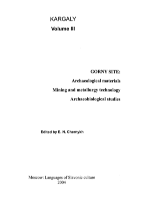
Стр.3
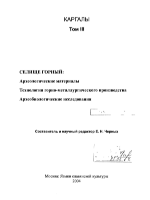
Стр.4

Стр.8
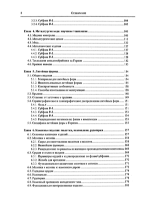
Стр.9
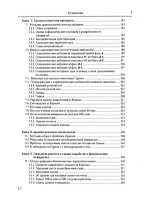
Стр.10

Стр.11

Стр.12
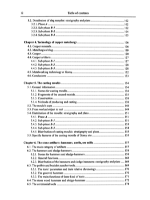
Стр.13

Стр.14
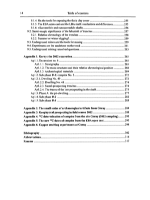
Стр.15
Каргалы.pdf
KARGALY
Volume Ill
GORNY SITE:
Archaeological materials
Mining and metallurgy technology
Archaeobiological studies
Edited by E. N. Chernykh
Moscow: Languages of Slavonic culture
2004
Стр.3
KAPrAnbl
ToM Ill
CEJIHIIJ;E rOPHhiH:
ApxeoJioruqecKue MaTepuaJILI
TexuoJiorun ropuo-MeTaJIJiypruqecKoro npoH3BOJJ:CTBa
Apxeo6uoJioruqecKue uccJiet~:osauun
,-.~~CocTaBMTenb
"" Hay~HbiM pe.qaKTop E. H. llepHbiX
-
!
MocKBa: .513hiKH cnaBHHCKoii IcyJibTYIJbi
2004
Стр.4
OrnaaneHMe
Bse)J;eHHe. Cneu.Hci»HKa apxeOJIOrH'IeCKHX MaTepHaJIOB c ropuoro ................................. l5
B.l.
euoMeHa.JibHrui uachiii~eHHOCTh cnog apxeonornqecKHMH MaTepHanaMH ............... 15
B.2. KaqecTBeHHhie OTJIHqH}I ............................................................................................. l6
B.3. BepmpHKa:QH}I cne.nos )I(HJHe.neBTeJibHOCTH .............................................................. 16
B.4. KJiaccHonorHqecKHe rpynnhi 6hiTOBOH KepaMHKH ............................................... 26
1.3. XapaKTepHCTHKa Bbi6opKH ......................................................................................... 50
1.4. OpuaMeHTa:QI{}I ........................................................................................................... 51
1.5. OpuaMeHTa.JihHbie KOMnOJH:QHH ................................................................................. 57
1.6. PeJI}ITHBHrui xpouonorl{}l THnos 6hiTOBOH KepaMHKH ................................................. 63
1.6.1. Pacnpe.neneuHe no xpouonorHqecKHM ropH30HTaM H coop~eHI{}IM ............... 63
1.6.2. PacceHsauHe yHK:QHOHa.JihHaB H MOpyH~HOHaJihHO ueonpe.neneHHhie o6pa.J:Qhi co cne,n:aMH o6pa60TKH .............. 90
2.2.4. 0TXO,llbl BblllJlaBKH H nJiaBKH Me,n:H .................................................................... 93
2.3. CTPaTHrpaqmqecKoe H nnauHrpaa.Jhi A .................................................................................................. 94
2.3 .2. MeTaJIJI cy6a.Jhi B-1 ......................................................................................... 96
2.3.3. MeTaJIJI cy6a.Jw B-2 ......................................................................................... 99
2.3.4. MeTaJIJI cy6HqecKoe pacnpe.neneuHe mnaKa ........................ I 02
3.2.1. PanHBJI 4>a3a A .................................................................................................. 102
3.2.2. Cy64>a.Ja B-1 ..................................................................................................... 102
Стр.8
8
OrnaaneHHe
3.2.3. Cy6$aJa B-2 ..................................................................................................... 104
3.2.4. Cy6$aJa B-3 ..................................................................................................... 105
rna sa 4. MeTaJIJiyprHH MeJJ:H: Hly'leHHe TeXHOJIOI'HH ................................................... 106
4.1. Me,n:HLie MHHepanbi .................................................................................................. 106
4.2. MeTan.nyprHqecKHe wnaKH ...................................................................................... 110
4.3. Me,n:L ......................................................................................................................... 120
4.4. MeTa.JIJIJt:qCCKHe HJ,n:eJuui ......................................................................................... 127
4.4.1. Cy6$aJa B-1 ...................................................... : .............................................. 127
4.4.2. Cy6$aJa B-2 ..................................................................................................... 128
4.4.3. Cy6$aJa B-3 ..................................................................................................... 128
4.5. TexHOJIOfHH MeTannoo6pa6oTKH Ha ropHOM ........................................................... 132
4.6. KpaTKHe BbiBO.ll:bi ...................................................................................................... 133
fJiaBa 5. JIHTeHHLie c(>opMLI .............................................................................................. 134
5 .1. 06mHe cse,n:eHHH ...................................................................................................... 134
5.1.1. MaTepHa.rrLI .li:JIH JIHTeHHbiX
aJaA .............................................................................................................. 151
5.4.2. Cy6$aJaB-1 ..................................................................................................... 151
5.4.3. Cy64>a3a B-2 ..................................................................................................... 153
5.4.4. Cy6yHKQHOHaJibHOe Ha3HaqeHHe MOJIOTKOB H MOJIOTOB ...................................... 171
6.4. MonoTKH H MOJIOTLI H3 KaMeHHoro .n;epesa .............................................................. 172
6.5. Tiapa,n:HLie opy,n:HH .................................................................................................... 174
6.6. HaKOBa.JILHH .............................................................................................................. 174
6.7. Py,n:oTepKH .................................................... ; ............................................................ 178
6.8. KaMeHHbiH IIpOTHBOBeC KOJIO,IJ.e3HOfO THIIa .............................................................. 179
6.9. yHKQHOHa.JlbHO Heorrpe,n:eneHHbie HJ,n:eJIHH ........................................................... 181
Стр.9
OrnaBJieHHe
rnasa 7. Apxe0300JIOrH1.feCKHe MaTepHaJibl. .................................................................. 182
7 .1. Mero.n;HKa apxeo3oonorHI.JecKoro HCCJie.n;oaaHHJI ..................................................... 182
7 .1.1. Oroop MaTepHanoa ........................................................................................... 182
7 .1.2. Ou.eHKa TacpOHOMHI.JeCKOrO COCTOHHWI H pa3.n;po6JieHHOCTH
MaTepHaJIOB ...................................................................................................... 183
7 .1.3. TaKCOHOM~P~ecKM H,Z:(eHrn$HKai.J.HH ................................................................. 184
7 .1.4. AHaTOMHI.JeCKHe xapaKTepHCTHKH .................................................................... 185
7 .1.5. CTaTHCT~P~eCKHH aHaJIH3 .................................................................................. 186
7.2. ba30Bbie xapaKTepHCTHKH OCTeOJIOr~P~eCKHX MaTepHaJIOB ...................................... 186
7 .2.1. OcTeonorHI.JeCKHe Bbi6opKH H3 coopyxKHoypanbCKOH CTeiiH ............................................ 247
rnasa 9. TeXHOJIOrHH pa3Be)J.OK H ropHbiX Bb1pa60TOK B 6poH30BOM BeKe
na Kapranax ....................................................................................................... 249
9 .I. Mero.n;bi pa3ae.n;KH B 6poH30BOM BeKe: KoppeKTHBbi ou:eHOK ................................... 249
9 .1.1. TpYJl.HOCTH «rrepBHI.JHbiX» paJae.n;oK Ha Kapranax ............................................ 251
9.1.2. flOHCKOBaH WaXTa 1103.li;He6poH30BOrO BeKa ..................................................... 251
9 .1.3. 3arronHeHHe waxn1 .......................................................................................... 252
9.1.4. 06 opy,n;HHX )l;Jij{ BCKpblTHH rJIHHHCTOro I.JeXJia ................................................ 255
9.1.5. Kapbep PEB H waxTa DEB: cxo.n;cTBO H pa3JIHI.JHe .......................................... 255
9.1.6. lllaxTbi y,n;ai.JHbie H Hey.n;ai.JHbie ......................................................................... 256
9
Стр.10
10
Ornasnemt:e
9.2. CaKpaJibHO-MarHqecKHH CMhiCJI Jia6HpHHTa Tpaullleii ............................................ 257
9.2.1. ,z:::{aTHpOBKa YpaHIIlCH ......................................................................................... 258
9.2.2. 3HMOH HJIH JICTOM? ........................................................................................... 259
9.3. fiO.LJ.3eMHbie Bbipa60TKH H opy.D.HH .D.JIH HX npOXO.D.KH ............................................... 259
9.4. 3KcnepHMeHTbl DO CKaJlbHbiM Bbipa60TKaM ............................................................. 261
9.5. llo.n.JeMuag pa6oTa: sonpocbi ocTaiOTCH .................................................................. 263
flpHJJOil\eHHe 1. ropHLIH: paCKOnKH 2002 roJ).a ............................................................... 265
llp1.1. PacKon 6 .............................................................................................................. 265
llp 1.1.1.CYpaTHrpaaJaA: MaJihie iKHJIHIUa ...................................................................................... 277
llp 1.4. Cy6
Стр.11
Table of contents
Introduction. Specific features of the archaeological materials of Gorny site ................ 15
B.1. The incredibly dense concentration of archaeological materials in
Gorny cultural layers ................................................................................................. 15
B.2. Qualitative differences ............................................................................................... 16
B.3. Verification of activity indicators ............................................................................... 16
B.4. The technology of production and classification of archaeological materials ........... 18
B.S. Recent literature on Kargaly (cont.) ........................................................................... 18
Chapter 1. Pottery ................................................................................................................. 22
1.1. Household ceramics: common notes .......................................................................... 22
1.2. Classification .............................................................................................................. 23
1.2.1. Principles and methods ....................................................................................... 23
1.2.2. Morphological groups of the household pottery ................................................ 26
1.3. Sampling characteristics ............................................................................................. 50
1.4. Decoration elements ................................................................................................... 51
1.5. Decoration compositions ............................................................................................ 57
1.6. Relative chronology according to the ceramic analysis ............................................. 63
1.6.1. Distribution of pottery fragments according to the chronological
phases and structures .......................................................................................... 63
1.6.2. Dispersion zone of one pot's fragments ............................................................. 66
1. 7. General development of the ceramics ........................................................................ 68
1.8. The crucibles ............................................................................................................... 70
1.8.1. General characteristics ........................................................................................ 70
1.8.2. The first group of crucibles ................................................................................. 70
1.8.3. The second group of crucibles ............................................................................ 73
1.8.4. Chronological distribution .................................................................................. 74
1.8.5. The crucibles and metal producing ..................................................................... 74
Chapter 2. Metal and copper artifacts ................................................................................ 76
2.1. General information .................................................................................................... 76
2.2. Functionally undetermined artifacts ........................................................................... 77
2.2.1. Tools and weapons .............................................................................................. 77
2.2.2. Ornaments .......................................................................................................... 87
2.2.3. Functionally undefined artifacts ......................................................................... 90
2.2.4. Metalworking refuse ........................................................................................... 93
2.3. Distribution of metal samples: stratigraphy and plans ............................................... 94
2.3.1. Phase A ............................................................................................................... 94
2.3.2. Sub-phase B-1 .................................................................................................... 96
2.3.3. Sub-phase B-2 .................................................................................................... 99
2.3.4. Sub-phase B-3 .................................................................................................... 99
2.4. Metal: certain results of the investigations ............................................................... 100
Chapter 3. The slag ............................................................................................................. I 0 I
3.1. Slag crushing ............................................................................................................ 101
2*
Стр.12
12
Table of contents
3.2. Distribution of slag samples: stratigraphy and plans ................................................ 102
3.2.1. PhaseA ............................................................................................................. 102
3.2.2. Sub-phase B-1 .................................................................................................. 102
3.2.3. Sub-phase B-2 .................................................................................................. 104
3.2.4. Sub-phase B-3 .................................................................................................. 105
Chapter 4. Technology of copper metallurgy ................................................................... 106
4.1. Copper minerals ........................................................................................................ 106
4.2. Metallurgical slag .......................................................... : .......................................... 110
4.3. Copper ...................................................................................................................... 120
4.4. Copper artifacts ......................................................................................................... 127
4.4.1. Sub-phase B-1 .................................................................................................. 127
4.4.2. Sub-phase B-2 .................................................................................................. 128
4.4.3. Sub-phase B-3 .................................................................................................. 128
4.5. Metalworking technology at Gomy .......................................................................... 132
4.6. Conclusions .............................................................................................................. 133
Chapter 5. The casting moulds .......................................................................................... 134
5.I. General information .................................................................................................. 134
5.1.1. Stones for casting moulds ................................................................................. 134
5.1.2. Fragments of the unused moulds ...................................................................... 135
5. I .3. Construction ..................................................................................................... 138
5.1.4. Methods ofproducing and casting ................................................................... 138
5.2. The mould's caps ...................................................................................................... I48
5.3. From worked object to tool ...................................................................................... I49
5.4. Distribution of the moulds: stratigraphy and plans .................................................. 151
5.4.1. Phase A ............................................................................................................. I 51
5.4.2. Sub-phase B-1 .................................................................................................. I5I
5.4.3. Sub-phase B-2 .................................................................................................. 153
5.4.4. Sub-phase B-3 .................................................................................................. 154
5.4.5. Distribution of casting moulds: stratigraphy and plans .................................... I 55
5.5. Specific features of the casting moulds of Gorny site .............................................. 155
Chapter 6. The stone artifacts: hammers, anvils, ore mills ............................................ 157
6. I. The main category of artifacts .................................................................................. 157
6.2. The hammers and sledge-hammers .......................................................................... 158
6.2.1. Stones for hammers and sledge-hammers ........................................................ 158
6.2.2. General functions .............................................................................................. 168
6.2.3. Distribution of the hammers and sledge-hammers: stratigraphy and plans ..... 169
6.3. The pebble and boulder puncher tools ...................................................................... I69
6.3. I. The tools' parameters and their relative chronology ........................................ 170
6.3.2. The grooved hammers ...................................................................................... 170
6.3.3. The main functions of these kind of tools ........................................................ 171
6.4. The stone wood hammers and sledge-hammers ....................................................... 172
6.5. The ceremonial tools ................................................................................................ 174
Стр.13
Table of contents
6.6. The anvils ................................................................................................................. 174
6. 7. The ore mills ............................................................................................................. 178
6.9. The heavy balance weight ........................................................................................ 179
6.8. The functionally undetermined artifacts ................................................................... 181
Chapter 7. Faunal materials .............................................................................................. 182
7.1. Methods ofarchaeozoological studies ...................................................................... 182
7 .1.1. Selection of materials ....................................................................................... 182
7 .1.2. Evaluation of taphonomy and degree of crushing of materials ........................ 183
7 .1.3. Taxonomic identification .................................................................................. 184
7 .1.4. Anatomical characteristics ................................................................................ 185
7.1.5. Statistical analysis ............................................................................................ 186
7 .2. Basic characteristics of the bones ............................................................................. 186
7.2.1. The selection of bones from phase A constructions ......................................... 189
7.2.2. The selection of bones from complex No. 1 (sub-phase B-1) .......................... 195
7.2.3. The selection ofbones from complex No.2 (sub-phase B-1) .......................... 201
7.2.4. The selection of bones from sub-phase B-2layers ........................................... 206
7.2.5. The selection of bones from sub-phase B-3layers ........................................... 207
7.2.6. Faunal remains from the two main periods of the Gorny settlement ............... 209
7.3. Animals in the sacral complexes .............................................................................. 210
7.4. Sex-age groups and morphological specificity of domestic species ......................... 212
7.4.1. Cattle ................................................................................................................ 213
7.4.2. Sheep and goats ................................................................................................ 217
7.4.3. Horses ............................................................................................................... 219
7.4.4. Pigs ................................................................................................................... 220
7.5. Meat consumption at Gorny ..................................................................................... 221
7 .6. Was there stock-breeding at Gorny? ......................................................................... 222
7. 7. Bone artifacts ............................................................................................................ 223
7.8. The bone collection from the «Russian house» (18th century) ................................. 233
7.9 The bone collection from the 2002 field season (excavation No. 6) ....................... 235
7.9.1. Animal bones .................................................................................................... 235
7.9.2. Bone artifacts .................................................................................................... 238
7.9.3. Human remains ................................................................................................. 239
Chapter 8. Archaeobotanical investigations ..................................................................... 240
8.1. Sampling and processing methods ........................................................................... 240
8.2. Results of the analyses of archaeobotanical materials .............................................. 240
8.3. The problem of using dung as a fuel at Gorny ......................................................... 244
8.4. Was there farming in Gorny and in the South-Urals steppe? ................................... 247
Chapter 9. Technology of geological prospecting and mining in Kargaly ..................... 249
9.1. Prospecting methods in the Bronze Age: critical estimates ...................................... 249
9.1.1. Initial prospecting at Kargaly: specific difficulties ........................................... 251
9.1.2. The LBAprospecting shaft in Gorny ............................................................... 251
9.1.3. The filling up of the shaft ................................................................................. 252
13
Стр.14
14
Table of contents
9.1.4. On the tools for exposing the thick clay cover ................................................. 255
9 .1.5. The EBA open cast and the LBA shaft: similarities and differences ................ 255
9.1.6. «Successful» and «unsuccessful>> shafts .......................................................... 256
9.2. Sacral-magic significance of the labyrinth oftrenches ............................................. 257
9.2.1. Relative chronology of the trenches ................................................................. 258
9.2.2. Summer or winter digging? .............................................................................. 259
9.3. Underground mines and the tools for mining ........................................................... 259
9.4. Experiments on the sandstone mother rock .............................................................. 261
9.5. Underground mining: unsolved questions ................................................................ 263
Appendix 1. Gorny: the 2002 excavation .......................................................................... 265
Ap 1.1. Excavation no. 6 ............................................................................................. 265
Ap 1.1.1. Stratigraphy ............................................................................................ 265
Ap 1.1.2. The main structures and their relative chronological position ............... 268
Ap1.1.3. Archaeological materials ........................................................................ 269
Apl.2. Sub-phase B-1: complex No. 3 ....................................................................... 272
Ap1.2.1. Dwelling No. 49 .......................................................................................... 272
Apl.2.2. Dwelling No. 48 ..................................................................................... 274
Ap1.2.3. Sacral-prospecting trenches .................................................................... 274
Apl.2.4. The traces of the late prospecting in the shaft ........................................ 275
Ap1.3. Phase A: the pit-dwelling ................................................................................ 277
Apl.4. Sub-phase B-2 .................................................................................... ~ ........... 282
Apl.5. Sub-phase B-3 ................................................................................................ 283
Appendix 2. The small series of archaeological artifacts from Gorny ........................... 284
Appendix 3. Geophysical prospecting in field season 2002 ............................................. 288
Appendix 4. 14
Appendix 5. The new 14
C determination of samples from the site Gorny (2002 sampling) ......... 293
C dates of samples from the EBA open cast.. ............................ 295
Appendix 6. Copper smelting experiments at Gorny ...................................................... 298
Bibliography ........................................................................................................................ 302
Abbreviations ...................................................................................................................... 316
Resume ................................................................................................................................ 317
Стр.15